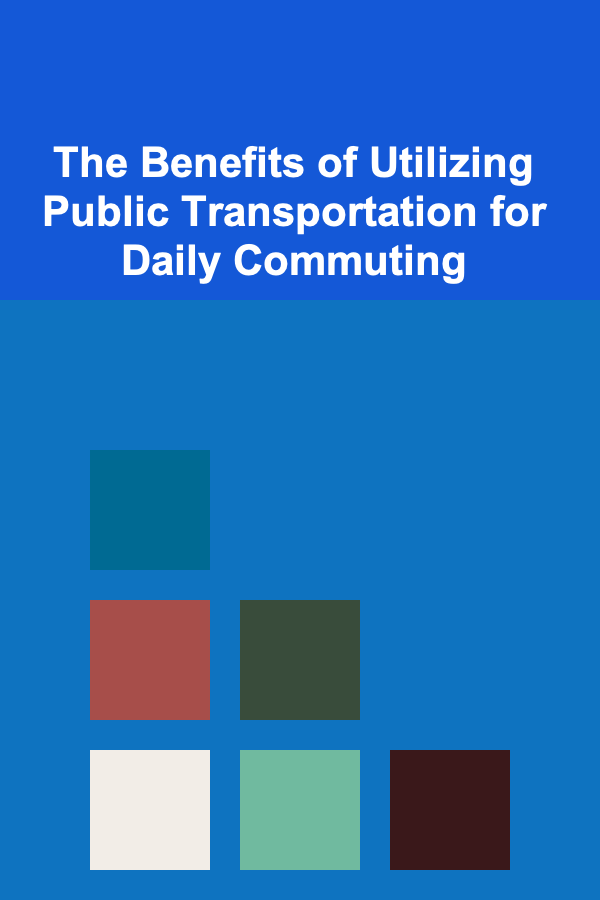
The Benefits of Utilizing Public Transportation for Daily Commuting
ebook include PDF & Audio bundle (Micro Guide)
$12.99$11.99
Limited Time Offer! Order within the next:

In an age where urbanization continues to grow and traffic congestion becomes an ever-increasing issue, the importance of public transportation as a daily commuting option cannot be overstated. Public transportation offers a range of benefits not only to individual commuters but also to society as a whole. From environmental advantages to economic savings and even health benefits, public transport is a sustainable solution to many of the challenges we face in modern urban life.
This article explores the multiple benefits of utilizing public transportation for daily commuting, offering actionable insights for individuals, communities, and cities striving for a more efficient, sustainable, and equitable transportation system.
Environmental Benefits: A Step Toward Sustainability
The environmental impact of our daily commuting choices is profound. Private vehicles contribute significantly to air pollution, greenhouse gas emissions, and the depletion of natural resources. Public transportation, on the other hand, offers a more eco-friendly alternative.
Reduced Carbon Footprint
Public transportation is one of the most effective ways to reduce the carbon footprint of daily commuting. A single bus, train, or tram can carry dozens of passengers at once, reducing the number of individual cars on the road. According to the American Public Transportation Association (APTA), public transit helps avoid the emission of 37 million tons of carbon dioxide annually in the United States alone. By opting for public transport, commuters can significantly lower their personal carbon footprints, contributing to global efforts in mitigating climate change.
Lower Air Pollution Levels
By reducing the number of cars on the road, public transportation helps lower the amount of pollutants, such as nitrogen oxide and particulate matter, in the atmosphere. These pollutants are known to contribute to smog and respiratory problems, leading to better air quality in urban areas. In cities where public transportation is widely used, air quality tends to improve, benefiting the health of all residents.
Conservation of Resources
Public transportation relies on energy sources that can be more sustainable than the individual use of gasoline or diesel cars. Many public transit systems are transitioning to electric buses, trains, and trams, further reducing the reliance on fossil fuels. Moreover, large-scale use of public transit encourages cities to invest in more sustainable and energy-efficient infrastructure.
Economic Benefits: Cost-Effective Commuting
For individuals and families, daily commuting via private vehicles can become a financial burden. The costs associated with owning and maintaining a car---fuel, insurance, parking fees, repairs, and depreciation---can add up quickly. In contrast, public transportation provides an affordable alternative, which can free up resources for other priorities.
Lower Commuting Costs
Public transportation is often more cost-effective than driving, especially when considering the cumulative expenses of car ownership. Commuters who use buses, trains, or subways can save money on fuel, car insurance, tolls, and parking. In cities with well-developed public transit networks, the cost of a monthly or annual transit pass is a fraction of what it would cost to own and maintain a car.
Reduced Traffic Congestion: Time and Productivity Savings
Traffic congestion is a common frustration for commuters, especially in busy metropolitan areas. Time spent stuck in traffic could otherwise be used more productively, either for work or personal activities. By utilizing public transportation, individuals can bypass traffic jams and reduce the time spent commuting. Furthermore, while on public transport, commuters can read, work, or relax, thus improving their productivity and overall well-being.
Economic Benefits for Cities
Cities that invest in public transportation infrastructure can enjoy significant economic benefits. Efficient transit systems attract businesses, promote tourism, and reduce the strain on roadways, lowering maintenance costs. Public transit also supports local economies by connecting people to jobs, services, and retail hubs. For businesses, having a reliable and accessible transit system means easier recruitment and retention of workers, as employees are more likely to commute using convenient transportation options.
Health Benefits: A Path to Wellness
The advantages of public transportation extend beyond environmental and economic factors---there are also significant health benefits associated with using public transit on a regular basis.
Increased Physical Activity
While many commuters in cars lead sedentary lifestyles, public transportation often requires some level of physical activity. This can range from walking to a nearby bus stop or train station to climbing stairs in subway stations. According to studies, people who use public transit typically walk more than those who rely on cars. The simple act of walking to and from stops or stations adds valuable physical activity to a person's day, contributing to overall cardiovascular health and fitness.
Reduced Stress and Mental Health Benefits
Commuting by car can be stressful, especially in cities with heavy traffic. The mental toll of dealing with road rage, constant stop-and-go driving, and long hours in the car can lead to higher levels of stress and anxiety. Public transportation, on the other hand, allows commuters to relax and unwind, providing opportunities for reading, listening to music, or simply enjoying some downtime. For those who use public transport regularly, this can have positive effects on mental health and overall well-being.
Better Air Quality and Health Outcomes
As mentioned earlier, public transportation helps reduce air pollution, which has a direct impact on public health. Reducing car emissions lowers the concentration of harmful pollutants like particulate matter and ozone, both of which are linked to respiratory and cardiovascular diseases. By reducing exposure to these pollutants, public transportation systems contribute to better overall health for city dwellers.
Social and Community Benefits: Building Stronger Cities
Public transportation doesn't just benefit the individual commuter---it also plays a crucial role in strengthening communities and promoting social inclusion.
Increased Access to Opportunities
For many people, especially those who do not own a car or cannot afford private transportation, public transit is the key to accessing essential services, including healthcare, education, and employment. Public transit provides equitable access to opportunities, helping ensure that all members of society, regardless of income, have the ability to participate fully in urban life.
Promoting Social Interaction
Public transportation fosters greater social interaction and a sense of community. Commuters who use buses, trains, or trams are often in close proximity to one another, which can lead to spontaneous conversations or even the creation of friendships. In addition, public transport is often a melting pot of people from diverse backgrounds, contributing to a more inclusive society.
Reducing Urban Sprawl
Public transportation systems also help combat urban sprawl by promoting more efficient land use. Cities with strong public transit networks tend to have higher-density housing, which reduces the need for extensive urban expansion. This not only saves valuable land but also prevents the environmental and infrastructural costs associated with sprawling suburban development.
How to Maximize the Benefits of Public Transportation
To fully realize the benefits of public transportation, individuals, communities, and governments must work together to ensure that systems are efficient, accessible, and inclusive. Here are some actionable steps to maximize the advantages of using public transportation for daily commuting:
For Individuals:
- Plan Your Commute: Take the time to familiarize yourself with local transit routes and schedules. Use apps and websites that provide real-time updates to ensure smooth and timely commutes.
- Stay Healthy: Use your commute as an opportunity to get some light exercise, such as walking to and from your stop or station.
- Support Sustainable Transit Policies: Advocate for sustainable public transport policies and encourage others to use public transportation.
For Communities:
- Promote Inclusivity: Ensure that public transportation systems are accessible to everyone, including people with disabilities, the elderly, and low-income communities.
- Create Multimodal Solutions: Encourage the integration of different modes of transport (buses, trains, bicycles, etc.) to provide a seamless travel experience for commuters.
For Governments and Urban Planners:
- Invest in Infrastructure: Invest in the expansion and maintenance of public transportation systems to ensure that they meet the growing demands of urban populations.
- Encourage Public-Private Partnerships: Collaborate with private companies to offer innovative solutions such as bike-sharing programs, carpooling apps, and ride-hailing services that complement public transit.
- Implement Policies that Incentivize Public Transit Use: Offer subsidies, tax incentives, and discounts for frequent riders to make public transportation more attractive.
Conclusion
Utilizing public transportation for daily commuting offers a wealth of benefits, from environmental sustainability to cost savings and improved health outcomes. By choosing public transit, individuals contribute to reducing traffic congestion, lowering pollution, and promoting healthier lifestyles, all while supporting the growth of more inclusive, sustainable cities. With thoughtful investment in infrastructure and policies, public transportation can become the cornerstone of urban mobility, making cities more livable for future generations.
Reading More From Our Other Websites
- [Personal Care Tips 101] How to Make Your Own Healthy Protein Bars at Home
- [Home Budget Decorating 101] How to Add Personality to Your Home with Budget-Friendly Accessories
- [Weaving Tip 101] From Looms to Shuttle: Modern Innovations in Weaving Equipment
- [Organization Tip 101] How to Use Mason Jars for Organizing Small School Items
- [Organization Tip 101] How to Organize Food Storage in a Shared Kitchen
- [Personal Care Tips 101] How to Create a Luxurious Shaving Routine with Shaving Cream
- [Home Renovating 101] How to Create an Open Floor Plan in a Small Home Renovation
- [Organization Tip 101] How to Organize a Family Calendar for Everyone's Activities
- [Home Holiday Decoration 101] How to Create a Holiday Display with DIY Craft Projects
- [Home Security 101] How to Manage Guest Access for Home Security

How to Keep Your Closet Organized Year-Round
Read More
How to Set Up Your Amazon Seller Account for Custom Products
Read More
How to Fuel Your Workouts for Weight Loss Success
Read More
Choosing the Right Eyeglasses to Enhance Your Face
Read More
How to Use a Job Application Checklist to Stay Organized
Read More
How to Build a Sustainable Travel Itinerary: Minimizing Your Impact
Read MoreOther Products

How to Keep Your Closet Organized Year-Round
Read More
How to Set Up Your Amazon Seller Account for Custom Products
Read More
How to Fuel Your Workouts for Weight Loss Success
Read More
Choosing the Right Eyeglasses to Enhance Your Face
Read More
How to Use a Job Application Checklist to Stay Organized
Read More